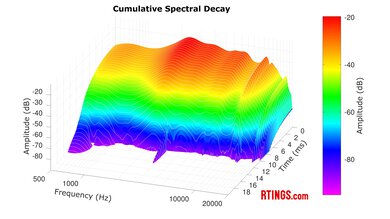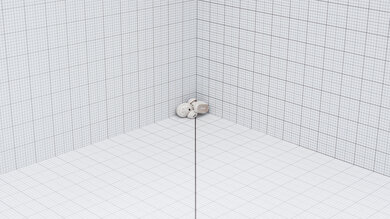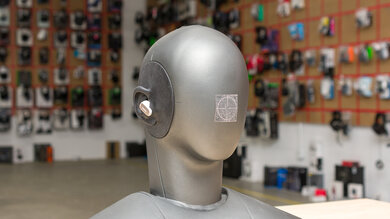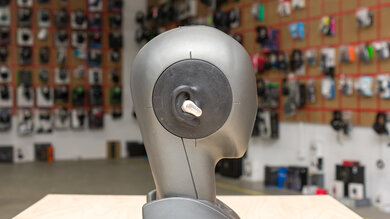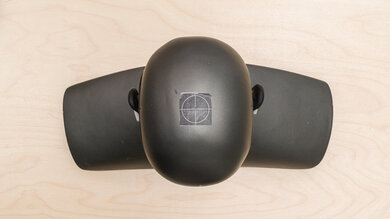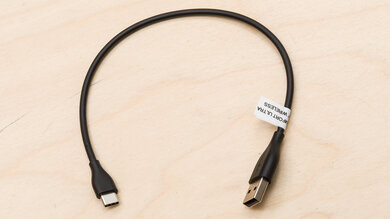The Bose QuietComfort Ultra Earbuds Truly Wireless are the next generation of the QuietComfort Earbuds II Truly Wireless. They're premium, wireless in-ear headphones that feature industry-leading active noise cancelling (ANC) technology, making them an excellent choice for those who want to block out external sounds so they can focus on their tunes. Released less than a year after their predecessor, these buds utilize the same sleek design but add Immersive Audio, a new virtual soundstage feature developed by Bose that aims to bring the kind of spatial audio features seen in the Apple AirPods Pro 2 to the QuietComfort lineup.
Our Verdict
The Bose QuietComfort Ultra Earbuds are impressive for sports and fitness use. They have a lightweight design that forms a stable fit in your ears, thanks to the variety of stability fins and ear tips provided. They're also IPX4 certified against splashes of water, and their ANC can be adapted to incorporate more ambient noise, which is great for runners who like to stay aware of their surroundings.
- IPX4 certified against splash damage.
- Comfortable fit and lightweight design.
Ear tips can easily tear.
The Bose QuietComfort Ultra Earbuds are great for commuting and travel. They're comfortable and portable, and you can supplement their seven-hour battery life with extra charges from the included case if you're in a pinch. As expected, the ANC performance is excellent and isolates well against everything from low engine rumble to high-frequency sounds like office chatter and fridge hum. You can also customize the ANC performance via the app and create presets for your needs.
- Excellent noise isolation performance.
- IPX4 certified against splash damage.
- Comfortable fit and lightweight design.
- Easy-to-use, intuitive control scheme.
Ear tips can easily tear.
The Bose QuietComfort Ultra Earbuds are good for office use. They're comfortable enough to wear all day, and their ANC does an excellent job of shielding you from background chit-chat and other distracting noises. That said, their seven-hour continuous battery life won't be enough to get you through a long day at the office without recharging from the case. Their microphone is adequate overall and should perform just fine in most office environments (in the absence of loud, sustained noise like construction).
- Excellent noise isolation performance.
- Comfortable fit and lightweight design.
- Case doesn't support wireless charging.
The Bose QuietComfort Ultra Earbuds are Bluetooth headphones not designed for wireless gaming. Their latency via SBC is quite high and can cause lip-sync issues. That said, they also support aptX Adaptive, which can adjust its performance to help lower latency if you're gaming.
The Bose QuietComfort Ultra Earbuds are Bluetooth-only headphones, and you can't use them wired.
The Bose QuietComfort Ultra Earbuds have satisfactory audio reproduction accuracy. Their warm sound profile suits many genres, from bass-heavy techno to vintage jazz, and if you like a little more sparkle, you can always add it via EQ in the companion app. That said, some large peaks and dips in the treble region mean vocals can sound both harsh and veiled at the same time, while a mediocre group delay performance means very low sounds like 808 kick drums can feel a bit flabby. Still, their left and right drivers are incredibly well-matched, so sounds are accurately located in the stereo field.
The Bose QuietComfort Ultra Wireless Noise Cancelling Earbuds have amazing noise isolation. They do an excellent job blocking out every day sounds like rumbly train engines or chatty coworkers. They also don't leak very much audio, so you won't disturb those around you.
The Bose QuietComfort Ultra Earbuds have an adequate microphone system. The mic does an okay job of capturing your voice and adequately separates it from most noise around you. In overwhelmingly loud environments, noise like subway arrivals can mask your voice.
The Bose QuietComfort Ultra Earbuds have an incredible frequency response consistency performance. As long as you take the time to achieve a good fit, with the right set of ear tips, you won't need to worry about any deviations in audio delivery. As a result, our frequency response measurements are indicative of what most people will experience.
Performance Usages
Changelog
-
Updated Oct 01, 2025:
We've updated Controls, Build Quality, Noise Isolation, Recording Quality, Noise Handling, Battery, and App Support as a result of retests with firmware 4.9.30. This also resulted in minor scoring changes for the Office Work and Microphone usages.
-
Updated Apr 29, 2025:
We've updated the Noise Isolation box to mention the Technics EAH-AZ100.
-
Updated Apr 25, 2025:
This review has been updated to Test Bench 2.0, which adds the following tests: Stereo Mismatch, Group Delay, Cumulative Spectral Decay, PRTF, Harmonic Distortion, and Electrical Aspects. We've added new performance usages and updated the text throughout the Sound tests and side-by-sides.
- Updated Apr 25, 2025: We've converted this review to Test Bench 2.0, which updates our sound tests and adds performance usages. You can read more about this in our changelog.
Check Price
Differences Between Sizes And Variants
The Bose QuietComfort Ultra Earbuds come in three standard color variations: 'Black,' 'White Smoke,' and 'Moonstone Blue.' We tested the 'White Smoke' variant; you can see our model's label here. At an additional cost, you can get a custom color version with engravings through ColorWare's website, and apart from the color, they're the same model. If you encounter another variant of these headphones, please let us know in the comments, and we'll update our review.
Popular Headphones Comparisons
The Bose QC Ultra Earbuds Truly Wireless are the next generation of the QuietComfort Earbuds II Truly Wireless. Their class-leading ANC performance has set them apart from other popular wireless earbuds like the Apple AirPods Pro 2, and they now have their own version of Apple's Spatial Audio feature called Immersive Audio. Their noise isolation performance is similar to their predecessor, and the two share a somewhat aligned sound profile. If you're in the market for in-ears to accompany you on your commutes, the Sony WF-1000XM5 Truly Wireless also have an amazing noise isolation performance but have a longer battery life.
If you're looking for more recommendations, check out our picks for the best noise cancelling headphones, the best wireless Bluetooth earbuds, and the best AirPods alternatives.
The Bose QuietComfort Ultra Earbuds Truly Wireless and the Sony WF-1000XM5 Truly Wireless are both premium wireless in-ears with similar strengths. Choosing between them is a matter of personal preference. Both buds are great for commuting and travel as they have a comfortable fit, decent battery life, and excellent overall ANC performance. You can also tweak the sound profiles of both buds to your liking via their EQ. However, the Sony headphones are slightly better for those who prioritize taking phone calls due to their superior noise-handling performance.
The Bose QuietComfort Ultra Earbuds Truly Wireless and Samsung Galaxy Buds3 Pro have different strengths that appeal to different people. The Bose's app works on Android/iOS and their battery life is slightly longer. They also have multi-device pairing with up to two devices and use aptX Adaptive alongside other high-quality codecs. The Samsung have a more in-depth equalizer, but it's limited to Android. Many of their features are restricted to Android or Samsung devices, such as the Samsung Seamless Codec and seamless device switching between devices signed into the same account. That said, their noise cancelling is a bit more powerful than the Bose's, which may edge them ahead.
The Sennheiser MOMENTUM True Wireless 4 and Bose QuietComfort Ultra Earbuds Truly Wireless have much in common, like their similar battery lives. Both earbuds support aptX Adaptive, including aptX Adaptive (Low Latency). The Sennheiser sound is less excited in the highs and they also have dust resistance with an IP54 rating, instead of just water resistance on the Bose's IPX4 rating. However, they're not as comfortable as the Bose, which reduce more low-pitched noise. And only the Bose earbuds include virtual surround sound, even if it's just a simulated DSP.
Owners of Android devices will have greater access to the full functionality of the Bose QuietComfort Ultra Earbuds Truly Wireless, thanks to their Android/iOS app, than the Apple AirPods Pro 3. Both are comfortable and stable wearing, but the Bose include EQ presets and a three-band EQ with adaptive EQ (called CustomTune). Their ANC is strong, but not quite as strong as the Apple's. They have an IPX4 rating, but the Apple have a more durable IP57 rating. The Apple also have a more advanced spatial audio feature, which can play Dolby Atmos mixes. Extra features include live translation, heart monitors, and the ability to use the buds as either hearing aids or hearing protection (region-dependent). Plus, their battery lasts longer over continuous use.
Test Results

The Bose QuietComfort Ultra Earbuds have a warm sound signature similar to their predecessor, the Bose QuietComfort Earbuds II Truly Wireless. If you prefer a different sound, the companion app offers a graphic EQ and presets that let you tweak the sound to your preferences.
Users contacted us regarding a high noise floor while the ANC was on, resulting in 'coil-like' sounds and beeps. While subjectively listening to the buds for a while with ANC on, we could also hear this kind of noise from our unit at random times, mostly from the left earbud. These buds also have a somewhat high noise floor, meaning the headphones generate quite a bit of their own sound. If you've experienced this issue, please inform us in the comments.
These Bose QuietComfort Ultra Earbuds have fantastic frequency response consistency. The manufacturer has implemented their CustomTune technology with these earbuds. This technology analyzes your ears and adjusts the ANC and sound profile over repeated uses. The manufacturer claims they'll adapt to your ears, listening environment, and musical preferences over time to optimize their performance. This means that the frequency response between listening sessions is slightly inconsistent compared to previous QuietComfort iterations, as the earbuds slightly re-tune the ANC and sound profile every time you use them. As a result, you might find it easier to get a more consistent sound after a few listening sessions.
The bass response has great compliance with our target. The response is overemphasized across the entire range, so kick drums have plenty of thump and punch. On tracks like Young Thug's Wyclef Jean, the subby bassline has plenty of rumble and punch, which complements the track's pared-down production.
These buds do an excellent job of complying with our mid-range target. While the whole range is quite balanced, there's a small boost in the low-mids that adds warmth to basslines but can also muddy up vocals. Similarly, a dip in the mid to high-mid nudges vocals and instruments to the back of the mix. This is particularly noticeable in bass-heavy tracks, where prominent drums and basslines slightly overshadow vocals and lead instruments. In songs like Mitski's I Love Me After You, the boomy, reverb-drenched kicks in the intro make the lead vocal and piano sound distant and less defined.
The compliance with our target in the treble range is impressive. The overall response is slightly tilted down, with a gentle reduction in amplitude the higher up the frequency range you go. The peak in the low treble makes vocals and instruments sound detailed and exciting, while sounds like cymbals are a little veiled at the top of the range.
The Bose QuietComfort Ultra Earbuds have decent peaks and dips performance. A peak between the high-mid and low-treble brings out the upper harmonics of vocals and instruments, and another peak in the mid-treble makes sibilants, like S and T sounds, overly bright. However, this is followed by a sharp dip between the mid and high-treble that can remove some of the airiness in female vocals.
These buds are fantastically well-matched in terms of amplitude and frequency response. Objects are precisely located in the stereo field, and sounds like percussion transients are well-defined. They're less well-matched when it comes to phase as there are some small mismatches in the mid-range, though they'll be audible only to the most astute audiophiles.
The group delay performance is passable. There are no issues through most of the frequency range, so sounds like cymbals sound clear and present. But group delay in the low-bass falls above the audibility threshold, meaning rumbly 808 kick drums feel a bit loose and flabby.
The Bose QuietComfort Ultra Earbuds' design means their audio bypasses your outer ear and does not interact with your pinna.
The Bose QuietComfort Ultra Earbuds have remarkably low distortion. Regardless of your listening level, your audio will be purely and cleanly reproduced.
Like the Bose QuietComfort Ultra Headphones Wireless, these buds feature Immersive Audio technology that you can use in either 'Still' or 'Motion' mode. 'Still' places the virtual speakers in front of you and tracks your head to ensure sound comes from the original direction of the audio. If you swivel your head to the left, the audio will seem like it's playing to your right. By contrast, the 'Motion' mode tracks your head to ensure that these virtual speakers stay positioned in front of you at all times. However, these buds lack the processing capabilities for multi-output surround sound content like Dolby Atmos. Instead, they use Digital Signal Processing (DSP) to virtually model a wider stereo soundstage.
These are the settings used to test the Bose QuietComfort Ultra Earbuds, and our results are only valid in this configuration.
The Bose QuietComfort Ultra Earbuds have kept the same sleek, streamlined look of the Bose QuietComfort Earbuds II Truly Wireless. These buds have a stem design and feature the manufacturer's logo embossed on the glossy exterior. As with the previous gen, the stability fins and ear tips are part of a swappable design that makes it easy to try out different fits. They come in three standard color variants: 'Black,' 'White Smoke,' and 'Moonstone Blue.' Customized buds can be purchased in various glossy or matte textured finishes at ColorWare for an added fee. On the site, you can mix and match a variety of neutral shades all the way through iridescent and neon colors with engravings on the case. Besides the exterior, these are all the same model.
The Bose QuietComfort Ultra Earbuds are very comfortable. Their ergonomic design ensures that the tips can create a good seal without going deep into your ear canal. The included selection of silicone ear tips makes it easy to achieve a comfortable fit, and the variety of stability fins provided allows you to find a set that feels snug and stable. The form factor of these buds does mean that they stick out of your ear slightly, and their fit can loosen if they get snagged on something or if you're lying down on your side.
The Bose QuietComfort Ultra Earbuds have good controls. You can tap the touch-sensitive surface on either bud to activate functions, and they have a nice responsiveness. However, it's easy to accidentally tap them while placing them in your ears. There's also no audio feedback to let you know when you've successfully registered a command, except for switching ANC modes and a max/min volume warning. With firmware 4.9.30, you can also disable all touch controls if you want to completely avoid accidental inputs.
On either bud:
- Single tap: Plays and pauses audio. Also accepts calls.
- Double tap: Skips to the next track. Also ends calls.
- Triple tap: Skips to the previous track.
- Touch and hold: By default, this cycles between ANC modes: 'Quiet', which is ANC on, and 'Aware', which is a talk-through mode, so that you can hear your environment without taking your earbuds out. You can also remap these controls to add a shortcut of your choice.
- Swipe up: Raises the volume.
- Swipe down: Lowers the volume.
The Bose QuietComfort Ultra Earbuds come with a good carrying case. It's made of hard plastic with a matte coating that feels smooth. The lid is magnetically secured, but it's made of hollow plastic that's not as sturdy as the rest of the case. There's also an LED power indicator to let you know the buds are charging. Sadly, this case doesn't feature wireless charging, which has been missing since the Bose QuietComfort Earbuds Truly Wireless.
These earbuds have a decent build quality that slightly disappoints compared to their predecessor, the Bose QuietComfort Earbuds II Truly Wireless. The buds are made of plastic with a metal strip on the stem that houses the touch-sensitive control surface. They're also certified IPX4 for resistance against splashes of water. The case feels decently sturdy despite its plastic construction. However, the case lid feels flimsier than the rest of the case, which detracts from the overall build quality. The silicone ear tips are also made of a soft, pliable material that tore easily throughout our testing process.
The Bose QuietComfort Ultra Earbuds have an excellent noise isolation performance. Like the Bose QuietComfort Earbuds II Truly Wireless, they use CustomTune technology, which adapts the ANC performance depending on your environment and ear shape, increasing and decreasing attenuation levels across different frequency ranges. As a result, ANC performance can differ across listening sessions, even if you achieve a similar in-ear fit. Using the 'Quiet' mode, which is the maximum setting for this feature, they can reduce higher frequency sounds like office chatter and fridge hum very well. However, they excel at providing isolation against bass-range noise like low engine rumbles. If you're looking for better full-range noise isolation, particularly against ambient voices in the mid-range, check out the Technics EAH-AZ100.
With firmware 4.9.30, we noticed slight improvements to raw ANC performance (which is reflected in the current results). That said, the most noticeable changes come with the introduction of 'ActiveSense,' which more effectively adapts to transient noises like a door slamming shut and attenuates them.
They do an excellent job tackling sounds you'll likely encounter in your day-to-day life. Their ANC system can isolate you from a large range of airplane noise, which is handy for long trips, as well as street noise. The ANC system also effectively tackles office noise like coworkers talking.
Unlike other sounds, wind directly interacts with the ANC's microphones. Even though this sound doesn't reach your ears, the ANC system still tries to cancel it out, causing loud and unwanted noise. At the same time, the amount of wind noise can vary depending on the angle due to the buds' shape and size. Unfortunately, they lack a wind reduction feature to help limit the annoyingness of this sound.
The leakage performance is great. Most of the leakage is between the mid to treble range, and escaping audio sounds thin. Even at higher volumes, your audio won't disturb people around you.
The integrated mic's recording quality is okay. The mic is far from your mouth, so your voice lacks body. However, you'll still be understandable to whoever's on the other end. We've also recorded a call to showcase the earbuds' mic system with a human speaking rather than our test rig.
The mic's noise handling performance is okay. While the Bose's noise handling performance was originally quite poor, firmware 4.9.30 introduced SpeechClarity processing. The new noise processing keeps your voice intelligible above moderate noise, though the mic system is overwhelmed when confronted with loud, sustained noise like a subway arriving at a station.
The Bose QC Ultra Earbuds have decent battery performance. The manufacturer advertises up to six hours of continuous battery life (up to four hours with Immersive Audio enabled), but we measured a little over that. The case also holds an additional three full charges, which can be useful if you need to recharge on the go. There's even a useful power-saving feature that puts the buds on standby mode when you take them out of your ears. It's also possible to use one of the buds while the other charges in the carry case. However, battery life can depend on use.
We've seen some user reports of battery charging issues with firmware update 4.9.30. However, we were able to drain and fully charge the earbuds without any issues. If you encountered a similar issue, please let us know in the comments.
Bose Music is a great companion app for these earbuds. It allows you to customize your audio experience by using EQ (both a graphic EQ and presets), and you can turn the 'Immersive Audio' function on/off with optional head tracking. You can adjust the volume, remap controls, and change the Bluetooth source. There's a 'shortcut' feature to allocate useful functions that are immediately accessed via the earbuds' touchpads. Plus, you get a handy earbud seal test that can tell you if you've achieved a good fit. With firmware 4.9.30, you can also set an exclusive Spotify shortcut and disable touch controls completely if you prefer to control playback and volume with your connected device.
Finally, there are plenty of options for adjusting the intensity of the ANC. You can toggle between three ANC modes by default: 'Quiet,' 'Aware,' and 'Immersion,' but you can also create new ANC presets and set custom levels for ANC and immersion levels. Moving the ANC slider doesn't decrease the strength of the ANC; it instead increases the Talk-Through strength relative to the ANC level. Increasing the Talk-Through strength will incorporate more audio from your surroundings, as captured by the built-in mic. Here is a video of the app.
The Bose QuietComfort Ultra Earbuds have good Bluetooth connectivity. They have Google Fast Pair, which lets you seamlessly connect to Android devices. As of firmware 4.0.20., they support multi-device pairing with two devices (as shown in this screenshot). This allows you to connect to two devices simultaneously, but you can only listen to music through one device at a time. You can also set up the 'Bluetooth Carousel' shortcut in the app to cycle through paired devices directly through the touch controls. Besides using the 'Bluetooth Carousel' shortcut, switching devices is as easy as pausing audio playback on the first device and hitting 'play' on the second connected device.
While the latency with the basic SBC codec is too high to watch videos without lipsync issues, there's a gaming mode that can help decrease the lag. You can also select aptX Adaptive (Low Latency) to lower latency if you're streaming video. aptX Adaptive uses variable transfer rates by design, so it can provide high-quality audio under ideal conditions with the aptX Adaptive (High Quality) setting. However, it doesn't have a consistent transfer rate like aptX Lossless codec, which is less common. Still, if you prioritize lossless audio above all, you can get it on the Creative Aurvana Ace 2 True Wireless. By comparison, the upside of aptX Adaptive is that you can prioritize low latency for watching video content without going out of sync.
Some users online have reported connectivity issues with these buds, whereby they would disconnect after a few minutes of playback. We tested them with a few devices but haven't encountered any connectivity issues. Please let us know in the comments if you've experienced such issues.
These earbuds can connect to Bluetooth-enabled PCs with full audio and mic compatibility. However, there's no other way to connect these headphones to your PC.

